
Scarabaeoidea is a superfamily of beetles, the only subgroup of the infraorder Scarabaeiformia. Around 35,000 species are placed in this superfamily and some 200 new species are described each year. Its constituent families are also undergoing revision presently, and the family list below is only preliminary. This superfamily includes some of the largest beetles extant today, including rhinoceros beetles, (Dynastinae), the Hercules beetle and Goliath beetles.
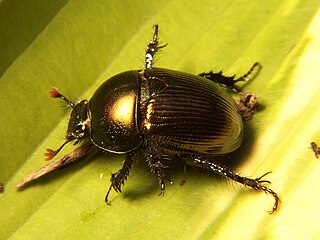
Geotrupidae is a family of beetles in the order Coleoptera. They are commonly called earth-boring dung beetles or dor beetles. Most excavate burrows in which to lay their eggs. They are typically detritivores, provisioning their nests with leaf litter, but are occasionally coprophagous, similar to dung beetles. The eggs are laid in or upon the provision mass and buried, and the developing larvae feed upon the provisions. The burrows of some species can exceed 2 metres in depth.

The rain beetles are a group of beetles whose extant species are found only in the far west of North America. They spend most of their lives underground, emerging in response to rain or snow, thus the common name. Formerly classified in the Scarabaeidae, they are currently assigned to their own family Pleocomidae, considered the sister group to all the remaining families of Scarabaeoidea. The family contains a single extant genus, Pleocoma, and two extinct genera, Cretocoma, described in 2002 from Late Cretaceous deposits in Mongolia, and Proteroscarabeus of Late Cretaceous China.
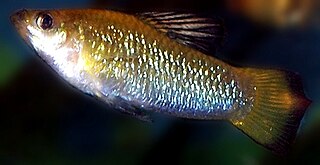
Limia is a genus of livebearing fishes belonging to the Cyprinodontiform family Poeciliidae, which includes other livebearers such as platys, swordtails, guppies and mollies. They are found in fresh and brackish water. Of the 21 described Limia species, 17 are endemic to Hispaniola, one is found on both Hispaniola and Jamaica, and the Cayman Islands, Cuba, and Venezuela have an endemic species each. Limia are popular in aquaria among more advanced hobbyists.
Lake Miragoâne is a lake in Haiti, located one kilometer southeast of the city of Miragoâne. It is one of the largest natural freshwater lakes in the Caribbean. The lake is 12 km (7.5 mi) long and 25 km² (9.7 mi²) in area.

Schilbe is a genus of schilbid catfishes native to Africa. Some are colloquially called butter catfish, though this may also refer to the Asian genus Ompok of the family Siluridae.
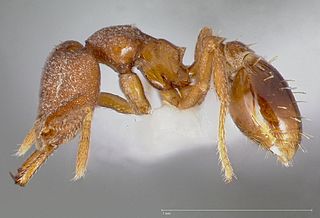
Strumigenys is a genus of ants in the subfamily Myrmicinae.
Antofagastaichthys is an extinct genus of ray-finned fish that lived in what is now Chile during the Oxfordian stage of the Late Jurassic epoch. It contains one species, A. mandibularis, which is known from several fragmentary specimens discovered in the El Profeta Formation of Antofagasta Province.
Geholaspis is a genus of mites in the family Macrochelidae. There are about 18 described species in Geholaspis.

Ecsenius mandibularis, also known as the many-toothed blenny, Queensland combtooth blenny or Queensland blenny in Australia, is a species of combtooth blenny in the genus Ecsenius. It is found in coral reefs in the western Pacific ocean, including the southern edge of the Great Barrier Reef. It can reach a maximum length of 7.5 centimetres. Blennies in this species feed primarily off of plants, including benthic algae and weeds.

Plectroctena is an Afrotropical genus of ants, with most species occurring in the rainforest zones of West and Central Africa. Some species are cryptic or subterranean foragers, while others forage in open grassland terrain. The workers forage singly or in groups of 2 to 3. They nest in the earth at varying depths, or in collapsed logs. They prey mainly on millipedes, including their young or eggs.
Cryptocharidius is a genus of ground beetles in the family Carabidae. This genus has a single species, Cryptocharidius mandibularis.
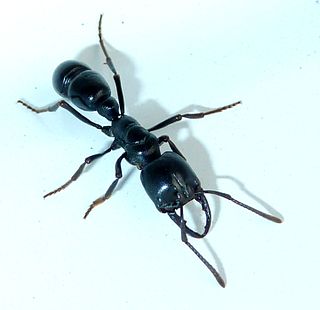
Plectroctena mandibularis is a large species of ant that ranges from the Eastern Cape, South Africa, through East Africa to Ethiopia. Their workers forage singly in open terrain, and their colony size seldom exceeds 50 individuals. It is one of the large Plectroctena species, including P. conjugata and P. minor, that specialize on adult millipedes as prey. The nest is composed of chambers that are typically located 2 feet or more below the surface, and the nest entrances are usually marked by large piles of earth.
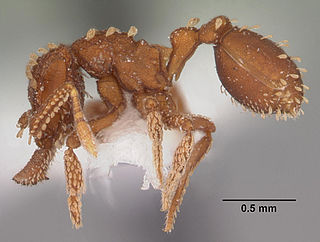
Talaridris is a genus of ant in the subfamily Myrmicinae containing the single species Talaridris mandibularis.
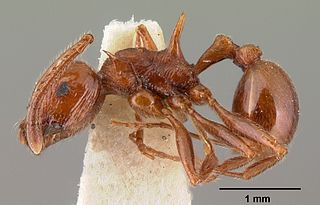
Pristomyrmex is a genus of ants in the subfamily Myrmicinae.

Lenomyrmex is a Neotropical genus of ant in the subfamily Myrmicinae.
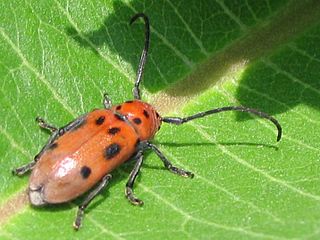
Tetraopes is a genus of longhorn beetles of the subfamily Lamiinae, tribe Tetraopini, containing the following species:

Baikuris is an extinct genus of ant in the Formicidae subfamily Sphecomyrminae, and is currently placed in the tribe Sphecomyrmini. The genus contains four described species: the type species Baikuris mandibularis, along with Baikuris casei, Baikuris maximus, Baikuris mirabilis, B. ocellantis.
Bolboceras insulare, is a species of dor beetle found in India, and Sri Lanka.
Bolbochromus lineatus, is a species of dor beetle endemic to Sri Lanka.













